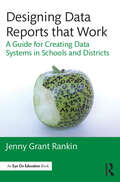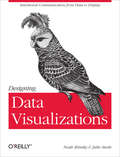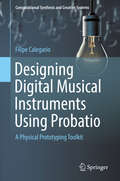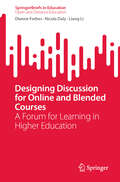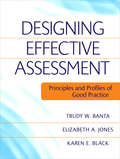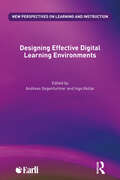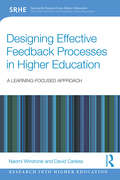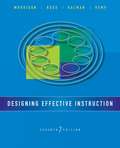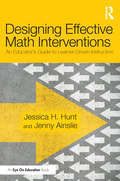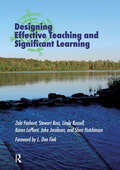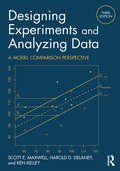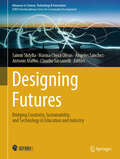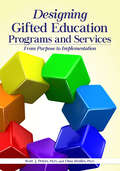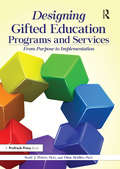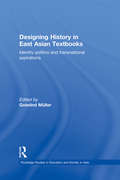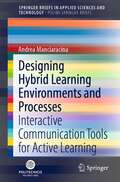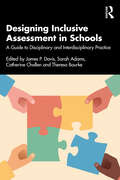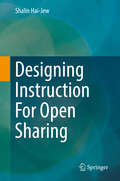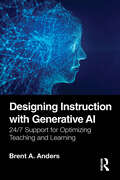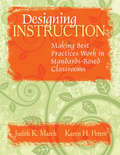- Table View
- List View
Designing Data Reports that Work: A Guide for Creating Data Systems in Schools and Districts
by Jenny Grant RankinDesigning Data Reports that Work provides research-based best practices for constructing effective data systems in schools and for designing reports that are relevant, necessary, and easily understood. Clear and coherent data systems and data reports significantly improve educators’ data use and save educators time and frustration. The strategies in this book will help those responsible for designing education data reports—including school leaders, administrators, and educational technology vendors—to create productive data reports individualized for each school or district. This book breaks down the key concepts in creating and implementing data systems, ensuring that you are a better partner with teachers and staff so they can work with and use data correctly and improve teaching and learning.
Designing Data Visualizations: Representing Informational Relationships
by Noah Iliinsky Julie SteeleData visualization is an efficient and effective medium for communicating large amounts of information, but the design process can often seem like an unexplainable creative endeavor. This concise book aims to demystify the design process by showing you how to use a linear decision-making process to encode your information visually.Delve into different kinds of visualization, including infographics and visual art, and explore the influences at work in each one. Then learn how to apply these concepts to your design process.Learn data visualization classifications, including explanatory, exploratory, and hybridDiscover how three fundamental influences—the designer, the reader, and the data—shape what you createLearn how to describe the specific goal of your visualization and identify the supporting dataDecide the spatial position of your visual entities with axesEncode the various dimensions of your data with appropriate visual properties, such as shape and colorSee visualization best practices and suggestions for encoding various specific data types
Designing Democratic Schools and Learning Environments: A Global Perspective
by Linda F. Nathan Jonathan F. Mendonca Gustavo Rojas AyalaThis open access book explores democratic schools and learning environments globally. The book focuses on a newly developed framework for democratic education. The authors describe existing schools and concept schools—those that are ideas but not in operation. The first section includes the editors’ own journeys Pillar One includes schools that emphasize the open flow of ideas and choices, regardless of their popularity. Pillar 2 maintains that it is impossible to have a high quality education that ignores equity. Chapters explore how many diverse ‘marginalized’ communities experience education and some innovations that hold great promise for inclusion. Pillar 3 provides examples of schools where active engagement, consensus and compromise support the ‘common good.’ Pillar 4 investigates schools which organize students, parents, social institutions and the larger community collaboratively to achieve its goals and to solve theirs and society’s most urgent challenges.
Designing Digital Musical Instruments Using Probatio: A Physical Prototyping Toolkit (Computational Synthesis and Creative Systems)
by Filipe CalegarioThe author presents Probatio, a toolkit for building functional DMI (digital musical instruments) prototypes, artifacts in which gestural control and sound production are physically decoupled but digitally mapped. He uses the concept of instrumental inheritance, the application of gestural and/or structural components of existing instruments to generate ideas for new instruments. To support analysis and combination, he then leverages a traditional design method, the morphological chart, in which existing artifacts are split into parts, presented in a visual form and then recombined to produce new ideas. And finally he integrates the concept and the method in a concrete object, a physical prototyping toolkit for building functional DMI prototypes: Probatio. The author's evaluation of this modular system shows it reduces the time required to develop functional prototypes. The book is useful for researchers, practitioners, and graduate students in the areas of musical creativity and human-computer interaction, in particular those engaged in generating, communicating, and testing ideas in complex design spaces.
Designing Digital Products for Kids: Deliver User Experiences That Delight Kids, Parents, and Teachers
by Rubens CantuniChildhood learning is now more screen-based than ever before, and app developers are flocking in droves to this lucrative and exciting market. The younger generation deserves the best, and growing up in a digital world has made them discerning and demanding customers. Creating a valuable user experience for a child is as complex and involved as when designing a typical app for an adult, if not more, and Designing Digital Products for Kids is here to be your guide. Author and designer Rubens Cantuni recognizes the societal importance of a high-quality and ethical app experience for children. There is room for significant improvement in this space, and Cantuni helps you optimize it. Designing Digital Products for Kids walks hopeful developers through digital product design—including research, concept, design, release, marketing, testing, analyzing, and iterating—all while aiming to build specifically for children. Industry experts and their real-world advice are showcased in this book, along with careful advice for the ethics that go along with this unique market. These tips include complex needs regarding mental development, accessibility, conscious screen time limits, and content sensitivity. Children, parents, and teachers alike are hungry for more thoughtful players in the kids’ app space, and Designing Digital Products for Kids is your ticket to successfully developing and educating for the future. What You Will LearnDesign platforms specifically for children, to entertain and educate themWork with a complex audience of parents, teachers and kidsUnderstand how different monetization strategies work in this industry and why Who This Book Is ForUser experience designers, UI designers, product owners, teachers and educators, startup founders. The range of topics is so wide that anyone interested or involved in digital products could find something interesting to learn.
Designing Discussion for Online and Blended Courses: A Forum for Learning in Higher Education (SpringerBriefs in Education)
by Liang Li Dianne Forbes Nicola DalyThis book supports teaching and learning through online discussion in higher education contexts such as universities, colleges, and polytechnics. It presents an explicit focus on popular asynchronous discussion tools and methods, with attention to disciplinary variety and key principles for successful learning-oriented discussion. It tackles the challenges faced by tertiary teachers implementing online discussion, and outlines common concerns and productive solutions to enhance the effectiveness and manageability of online discussions for teachers. This book also presents a parallel focus on the difficulties commonly experienced by students learning through online discussion. It offers advice for new online learners in a practical and accessible way, and considers assessment issues related to online discussion. Finally, this book offers innovative ideas for future-oriented online discussion in the higher education context.
Designing Effective Assessment
by Trudy W. Banta Karen E. Black Elizabeth A. JonesFifteen years ago Trudy Banta and her colleagues surveyed the national landscape for the campus examples that were published in the classic work Assessment in Practice. Since then, significant advances have occurred, including the use of technology to organize and manage the assessment process and increased reliance on assessment findings to make key decisions aimed at enhancing student learning. Trudy Banta, Elizabeth Jones, and Karen Black offer 49 detailed current examples of good practice in planning, implementing, and sustaining assessment that are practical and ready to apply in new settings. This important resource can help educators put in place an effective process for determining what works and which improvements will have the most impact in improving curriculum, methods of instruction, and student services on college and university campuses.
Designing Effective Digital Badges: Applications for Learning
by Joey R. Fanfarelli Rudy McDanielDesigning Effective Digital Badges is a hands-on guide to the principles, implementation, and assessment of digital badging systems. Informed by the fundamental concepts and research-based characteristics of effective badge design, this book uses real-world examples to convey the advantages and challenges of badging and showcase its application across a variety of contexts. Professionals in education, game development, mobile app development, and beyond will find strategies for practices such as credentialing, goal-setting, and motivation of their students.
Designing Effective Digital Learning Environments (New Perspectives on Learning and Instruction)
by Andreas Gegenfurtner Ingo KollarBringing together the research of leading international scholars in the field of digital learning, Designing Effective Digital Learning Environments discusses cutting-edge advancements in digital technology and presents an evidence-informed summary of best practices for effective design principles and implementation within educational settings.Readers will benefit from a synthesis of research evidence from previous meta-analyses on how to design digital environments that support learning, motivation, and collaboration. Divided into eight thematic parts, chapters unpack: An introduction to the design of digital learning environments Learning with multimedia, with particular emphasis on digital reading comprehension environments and GeoGebra software Digital videos for learning, including dynamic visualizations, instructional videos, and eye movement modeling examples Simulated realities, including learning with pedagogical agents and immersive virtual reality environments Game-based and sensor-based learning in digital environments Digital learning in social contexts, including a discussion of CSCL, social media, and audience response systems Design of digital classrooms, including flipped classroom approaches and synchronous online learning A concluding section discussing the efficacy and design of digital learning environments This edited volume is an essential read for any scholar, researcher, Ph.D., or Masters student working in the field of digital learning.
Designing Effective Feedback Processes in Higher Education: A Learning-Focused Approach (Research into Higher Education)
by David Carless Naomi WinstoneFeedback is one of the most powerful influences on student achievement, yet it is difficult to implement productively within the constraints of a mass higher education system. Designing Effective Feedback Processes in Higher Education: A Learning-Focused Approach addresses the challenges of developing effective feedback processes in higher education, combining theory and practice to equip and empower educators. It places less emphasis on what teachers do in terms of providing commentary, and more emphasis on how students generate, make sense of, and use feedback for ongoing improvement. Including discussions on promoting student engagement with feedback, technology-enabled feedback, and effective peer feedback, this book: Contributes to the theory and practice of feedback in higher education by showcasing new paradigm feedback thinking focused on dialogue and student uptake Synthesises the evidence for effective feedback practice Provides contextualised examples of successful innovative feedback designs analysed in relation to relevant literature Highlights the importance of staff and student feedback literacy in developing productive feedback partnerships Supports higher education teachers in further developing their feedback practice. Designing Effective Feedback Processes in Higher Education: A Learning-Focused Approach contributes to the theory and practice of higher education pedagogy by re-evaluating how feedback processes are designed and managed. It is a must-read for educators, researchers, and academic developers in higher education who will benefit from a guide to feedback research and practice that addresses well recognised challenges in relation to assessment and feedback.
Designing Effective Instruction
by Steven M. Ross Gary R. Morrison Jerrold E. Kemp Howard K. KalmanThis book includes many new, enhanced features and content. Overall, the text integrates two success stories of practicing instructional designers with a focus on the process of instructional design. The text includes stories of a relatively new designer and another with eight to ten years of experience, weaving their scenarios into the chapter narrative. Throughout the book, there are updated citations, content, and information, as well as more discussions on learning styles, examples of cognitive procedure, and explanations on sequencing from cognitive load theory.
Designing Effective Math Interventions: An Educator's Guide to Learner-Driven Instruction
by Jessica H. Hunt Jenny AinslieDesign effective, learner-driven math interventions with this accessible and thought-provoking guidebook. Learn how to set up instruction to promote participation and understanding, plan purposeful, targeted tasks, develop student thinking, and create tools to assess student work in a way that measures learning, not just performance. Chapters explore questions that educators frequently struggle with when designing interventions, offering user-friendly research and evidence-based strategies to help overcome common hurdles. This book is essential reading for anyone seeking an adaptive approach to Tier 2 and 3 interventions that positions struggling students as competent learners.
Designing Effective Mathematics Instruction: A Direct Instruction Approach
by Jerry Silbert Marcy Stein Douglas W. Carnine Diane B. KinderFor courses in Mathematics in Special Education. Providing teachers with the information needed to design supplemental mathematics instruction and to evaluate and modify commercially developed math programs, Designing Effective Mathematics Instruction, Fourth Edition, gives teachers systematic procedures and teaching strategies to augment instruction. The new edition discusses the history and components of the direct instruction approach to teaching mathematics, as well as relevant and current research skills and techniques required for effective mathematics instruction, including strategies for pacing lessons, correcting errors, and diagnosing and remedying error patterns. Designing Effective Mathematics Instruction also contains Instructional Sequence and Assessment Charts for primary, intermediate, and remedial teachers, which serve as diagnostic tests or as a basis for constructing goals and objectives for students.
Designing Effective Teaching and Significant Learning
by Stewart Ross Jake Jacobson Zala Fashant Linda Russell Karen LaPlantDesigning courses to deliver effective teaching and significant learning is the best way to set students up for success, and this book guides readers through the process. The authors have worked with faculty world-wide, and share the stories of how faculty have transformed courses from theory to practice. They start with Dee Fink’s foundation of integrating course design. Then they provide additional design concepts to expand the course blueprint to implement plans for communication, accessibility, technology integration, as well as the assessment of course design as it fits into the assessment of programs and institutions, and how faculty can use what they learn to meet their professional goals.
Designing Elementary Instruction and Assessment: Using the Cognitive Domain
by John L. Badgett Edwin P. ChristmannA practical guide for creating standards-based objectives and assessments aligned with Bloom’s Taxonomy! This user-friendly resource gives teachers clear, step-by-step guidelines for writing measurable objectives and developing appropriate formative and summative assessments to guide instruction in the elementary classroom. Providing detailed examples for all levels of Bloom’s Taxonomy, the authors cover unit and daily instructional objectives based on state and national content standards as well as all the major forms of assessment. Teachers discover how to: Deconstruct the standards and write concrete objectives Create true-false, fill-in-the-blank, matching, and multiple choice exercises Write short-answer questions and essay items Use performance-based assessments and portfolios
Designing Experiments and Analyzing Data: A Model Comparison Perspective, Third Edition (The\inquiry And Pedagogy Across Diverse Contexts Ser.)
by Scott E. Maxwell Harold D. Delaney Ken KelleyDesigning Experiments and Analyzing Data: A Model Comparison Perspective (3rd edition) offers an integrative conceptual framework for understanding experimental design and data analysis. Maxwell, Delaney, and Kelley first apply fundamental principles to simple experimental designs followed by an application of the same principles to more complicated designs. Their integrative conceptual framework better prepares readers to understand the logic behind a general strategy of data analysis that is appropriate for a wide variety of designs, which allows for the introduction of more complex topics that are generally omitted from other books. Numerous pedagogical features further facilitate understanding: examples of published research demonstrate the applicability of each chapter’s content; flowcharts assist in choosing the most appropriate procedure; end-of-chapter lists of important formulas highlight key ideas and assist readers in locating the initial presentation of equations; useful programming code and tips are provided throughout the book and in associated resources available online, and extensive sets of exercises help develop a deeper understanding of the subject. Detailed solutions for some of the exercises and realistic data sets are included on the website (DesigningExperiments.com). The pedagogical approach used throughout the book enables readers to gain an overview of experimental design, from conceptualization of the research question to analysis of the data. The book and its companion website with web apps, tutorials, and detailed code are ideal for students and researchers seeking the optimal way to design their studies and analyze the resulting data.
Designing Futures: Bridging Creativity, Sustainability, and Technology in Education and Industry (Advances in Science, Technology & Innovation)
by Angeles Sánchez Marina Checa Olivas Saimir Shtylla Antonio Maffei Claudio SassanelliThis book is a compelling exploration into the integration of sustainability with creativity and technology. It offers a cohesive journey from theoretical insights into practical applications across creative disciplines, education, and industries. This book serves as a crucial guide for those looking to navigate the challenges of modern sustainability through innovative solutions. By showcasing examples from 3D printing in education to sustainable practices in creative industries and the preservation of cultural heritage through digital innovation, it highlights the transformative power of creativity in fostering a sustainable future. Aimed at academics, professionals, and students, this book is an invitation to engage, innovate, and contribute to the sustainability discourse in the creative sectors.
Designing Gifted Education Programs and Services: From Purpose to Implementation
by Dina Brulles Scott PetersThis book is intended to support educators in the design and implementation of comprehensive gifted education plans. From planning to actual implementation, this book takes the reader from goals and purpose to assessing student needs and program design. The authors begin with a broad overview of best practices in programming and services, highlighting connections to student needs, programming standards, and state laws. Their recommendations include philosophical, cultural, and practical considerations and data-based decision making. In this book, Peters and Brulles guide the reader through the process of determining the most optimal programming methods for schools to take based on their individual needs and circumstances. With this book, schools will be able to design and develop programs and/or services that lay the foundation necessary to ensure all students are appropriately challenged.
Designing Gifted Education Programs and Services: From Purpose to Implementation
by Scott J. Peters Dina BrullesThis book is intended to support educators in the design and implementation of comprehensive gifted education plans. From planning to actual implementation, this book takes the reader from goals and purpose to assessing student needs and program design. The authors begin with a broad overview of best practices in programming and services, highlighting connections to student needs, programming standards, and state laws. Their recommendations include philosophical, cultural, and practical considerations and data-based decision making. In this book, Peters and Brulles guide the reader through the process of determining the most optimal programming methods for schools to take based on their individual needs and circumstances. With this book, schools will be able to design and develop programs and/or services that lay the foundation necessary to ensure all students are appropriately challenged.
Designing History in East Asian Textbooks: Identity Politics and Transnational Aspirations (Routledge Studies in Education and Society in Asia)
by Gotelind MüllerThis book analyses the efforts throughout East Asia to deploy education for purposes of political socialization, and in particular in order to shape notions of identity. The chapters also examine the trend of ‘common textbook initiatives’, which have recently emerged in East Asia with the aim of helping to defuse tensions arguably fuelled by existing practices of mutual (mis)representation. These are analysed in relation to the East Asian political context, and compared with previous and ongoing endeavours in other parts of the world, particularly Europe, which have been keenly observed by East Asian practitioners. Written by a group of international education experts, chapters discuss the enduring focus on the role of curricula in inculcating homogenous visions of the national self, and indeed homogenized visions of significant 'others'. Including contributions from scholars and curriculum developers involved personally in the writing of national and multi-national history textbooks this book will be of interest to students and scholars of Asian education, Asian history and comparative education studies. Gotelind Müller is Professor of Chinese Studies, University of Heidelberg, Germany
Designing Hybrid Learning Environments and Processes: Interactive Communication Tools for Active Learning (SpringerBriefs in Applied Sciences and Technology)
by Andrea ManciaracinaThis volume explores the relationship between space, pedagogy, and technology, with a particular focus on the latter since it is the connecting element that relates to all analysed contexts. The learning experience is investigated and supported by a review of works by referenced authors, underlining the active learning approach that can create better alliances among users and redefine the role of the teacher as a director and a facilitator. The volume offers a conceptualisation of learning technologies for innovative learning environments by creating a grid of technologies for active approaches. Then, it reflects on the comparison between the on-site and online learning environments, focusing on a stressful context. It offers and discusses an instructional design tool that supports teachers in designing hybrid learning contexts. Practitioners who wish to reframe technology in teaching using both digital and physical resources will find it very inspiring.
Designing Inclusive Assessment in Schools: A Guide to Disciplinary and Interdisciplinary Practice
by James P. Davis Sarah Adams Theresa Bourke Catherine ChallenWritten by teachers and teacher educators, this book presents practice-focused ideas and provocative questions to help teachers plan for inclusive curriculum and assessment within key learning areas in school education.Providing content on specific disciplines including geography, history, mathematics, science, English, and the Arts, this book supports teachers with hands-on examples for creating inclusive assessment practices in schools. There are additional sections on interdisciplinary perspectives delivering practical strategies for assessing students who use English as an additional language, being inclusive in relation to gender and sexual diversity, using a variety of technologies to promote inclusivity, and applying inclusive assessment in rural, regional, and remote contexts. Each chapter is designed around problems encountered by teachers, practical responses, and recommendations for practice. The authors address Australian Indigenous perspectives, gender and diversity, rural and remote school systems, and translanguaging for multicultural contexts.Engaging and easy to read, this book is essential reading for pre- and in-service teachers seeking to make an impactful contribution to inclusive education in their classrooms.
Designing Instruction For Open Sharing
by Shalin Hai-JewThis textbook considers and addresses the design of online learning objects, electronic textbooks, short courses, long courses, MOOC courses, and other types of contents for open sharing. It also considers the design of online mediated communities to enhance such learning. The “openness” may be open-access, and/or it may even be open-source. The learning may range from self-directed and automated to AI robot-led to instructor-led. The main concept of this work is that design learning for open sharing, requires different considerations than when designing for closed and proprietary contexts. Open sharing of learning contents requires a different sense of laws (intellectual property, learner privacy, pedagogical strategies, technologies, media, and others). It requires different considerations of learner diversity and inclusion. It requires geographical, cultural, and linguistic considerations that are not as present in more localized designs. The open sharing aspect also has effects on learner performance tracking (assessments) and learner feedback. This textbook targets students, both undergraduate and graduate in computer science, education and other related fields. Also, professionals in this field managing online systems would find this book helpful.
Designing Instruction with Generative AI: 24/7 Support for Optimizing Teaching and Learning
by Brent A. AndersDesigning Instruction with Generative AI offers a novel set of tools and strategies for leveraging generative AI to create engaging and personalized learning experiences. While instructional designers are a tremendous asset to higher education, not all colleges or universities have the robust staff needed to support all instructors on staff or large student populations. Drawing on a wealth of research, professional experience, and strategic insights, this book equips new and seasoned teaching faculty and trainers with step-by-step directions on how freely accessible artificial intelligence software can assist with all aspects of the course creation and instruction process and cater to the needs of diverse learners. Each chapter offers forward-thinking and empirically validated ways to help faculty create and improve instructional materials, course design, and learning environments while supporting their digital literacies. Rather than introduce AI as a means of outsourcing subject-area expertise, critical thinking, or cognitive processes, the author instead emphasizes its potential to build on traditionally honed knowledge and foundational instructional design practices. From optimizing course alignment and accessibility practices to fostering active learning, motivation, and engagement, educators will find new solutions to common teaching and learning challenges with greater efficiency in time and capacity.
Designing Instruction: Making Best Practices Work in Standards-Based Classrooms
by Judith K. March Karen H. PetersDemonstrates how to develop a standards-based curriculum, deliver and assess instruction with research-based best practices, and implement capacity-building processes that support a school's daily operation.
